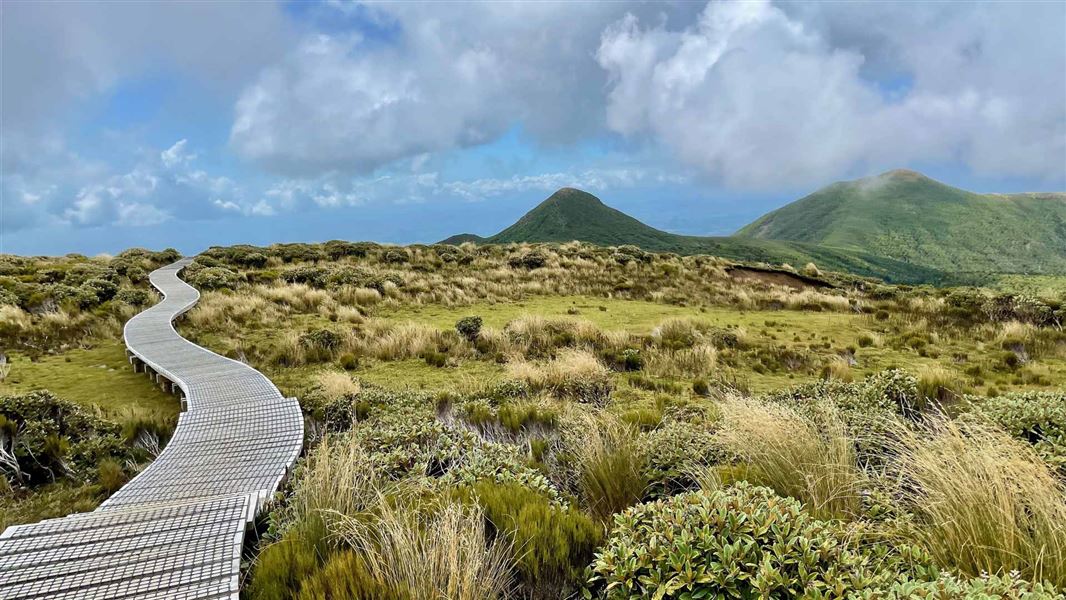5 km one way
Image gallery
Pouākai Hut closed from 30 September 2024 to mid-2025
Pouākai Hut and the nearby campsite will close for bookings from 30 September for redevelopment. We hope to open the new hut mid-2025.
Tramping the Pouākai Circuit will still be possible with an overnight stay at Holly Hut. Starting at North Egmont, this two-day tramp will consist of a shorter day of 3-4 hr (7.5 km) in to Holly Hut, followed by a longer day of 7-9 hr (17.5 km) back to North Egmont road end or vice versa.
Alternate overnight tramps include Maketawa Hut and Waingongoro Hut, Waiaua Gorge Hut or, in summer conditions, up to Syme Hut.
For more information contact Taranaki/Egmont National Park Visitor Centre, phone +64 6 756 0990.
From the car park, follow the path up to Mangorei Road and walk to the road end. Follow the track signage up a private driveway and into the bush.
This track requires good fitness as it involves several hours of walking uphill. This track is mostly wooden steps and batten boardwalk – be warned these can be a tripping hazard.
The track climbs steadily through regenerating forest, mountain cedar and low alpine scrub to the 16 bunk Pouākai Hut (stays must be booked in advance).
This is a good day tramp or you can stay overnight at Pouakai Hut.
Pouakai Tarns
Distance: 700 m
You can walk five minutes up past the hut for views of Ahukawakawa Swamp. From here, turn left at the track junction and follow the Pouakai Track for another ten minutes until you reach the Pouakai Tarns (pools).
The track begins at the car park at the end of Mangorei Road, around 20 minutes’ drive from New Plymouth.
Follow SH3 south from New Plymouth (towards Inglewood and Whanganui). Turn right onto Mangorei Road, then follow the road for 13.6 km. Turn into the car park on the right, just before the road end.
Shuttle transport options are available – search online for commercial operators.
Expect extreme weather
Taranaki is famous for its fast-changing and extreme weather. Check the forecast before you go and be prepared for rain and cold, even in summer.
This is an alpine area and it is common to have snow and ice on the higher parts of the track in winter. Contact the Egmont National Park Visitor Centre for current track conditions.
Pack warm and waterproof clothing
Be ready for any weather by packing a waterproof jacket and plenty of warm layers. Wear sturdy, comfortable shoes (tramping boots are recommended).
The majestic andesitic volcano Mount Taranaki or Egmont (2518 m) is the central point of the 34,170 ha Egmont National Park. Approximately 125,000 years old, it is the park’s most recent volcanic peak. Last erupting around 1755 AD the mountain is now considered dormant.
Local Māori believe Mounga (Mount) Taranaki once stood with the mountains of the central North Island. After a dispute over the maiden Pihanga, Taranaki fled his ancestral home, carving out the bed of the Whanganui River on his journey to the coast.
Egmont National Park became New Zealand’s second national park (after Tongariro) in 1900. Named Mount Egmont by Captain Cook, the traditional Māori name of Mount Taranaki is now more widely used.
Taranaki/Egmont National Park Visitor Centre
| Phone: | +64 6 756 0990 |
| Email: | egmontvc@doc.govt.nz |
| Address: | 2879 Egmont Road Egmont National Park 4386 |
| Hours: | Visitor centre hours and services |
